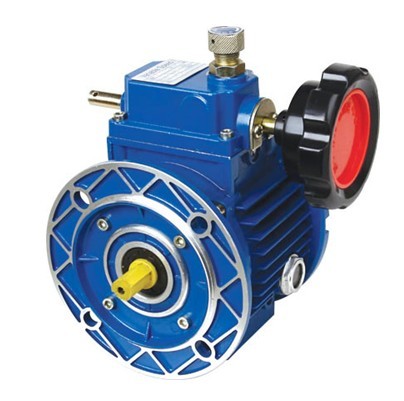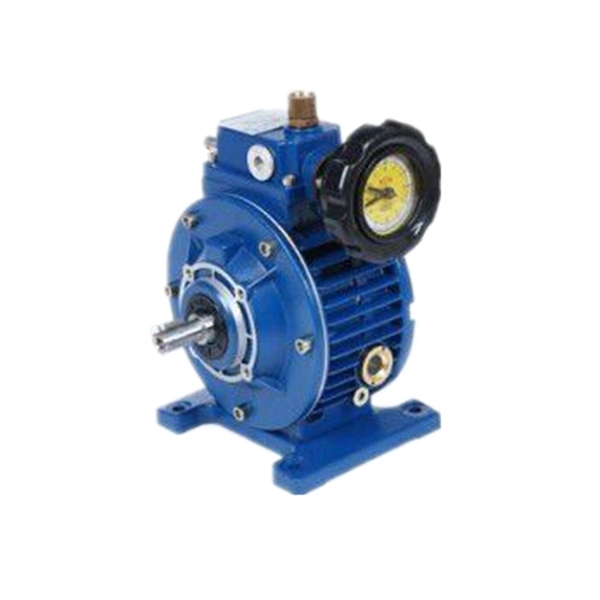Product Description
The design of UDL series planet cone-disk stepless speed variator compromises the advanced technology both at home and abroad.
The products include the following main characteristics:
1) High precision of speed regulating for speed variator,UD gear box: up to 0.5-1 round
2) Large speed-changing range: the speed ratio ranges from 1:1.4 to 1:7 freely
3) High intensity and long serving time
4) Convenient to regulate speed
5) Continuously workable, bidirectional working direction,smooth running,
stable, and quiet
6) Fully sealed and suitable to any environment
7) Compact structure, small size
8) High quality aluminum alloy die-cast, elegant shape, light weight and non-rusting
9) Good adaptability: can be combined with all kinds of reducers to achieve low
stepless speed changing
10) Input power: 0.18-7.5kW
UDL series planeet cone-disk stepless speed variator are widely used for foodstuffs, ceramics, packing, chemicals, pharmacy, plastics, paper-making, machine-tools, transportation, and all kinds of automatic production lines, pipelines and assembly lines which need speed-regulation, It is good companion for your production.
| Power | Model | I | n2(r/min) | M2(NM) |
| 0.18kw | UDL0.18 | 1.6-8.2 | 880-170 | 1.5~3 |
| 0.37kw | UDL0.37 | 1.4-7 | 1000-200 | 3~6 |
| 0.55kw | UDL0.55 | 1.4-7 | 1000-200 | 4~8 |
| 0.75kw | UDL0.75 | 1.4-7 | 1000-200 | 6~12 |
| 1.1kw | UD1.1 | 1.4-7 | 1000-200 | 9~18 |
| 1.5kw | UD1.5 | 1.4-7 | 1000-200 | 12~24 |
| 2.2kw | UD2.2 | 1.4-7 | 1000-200 | 18~36 |
| 3kw | UD3 | 1.4-7 | 1000-200 | 24~48 |
| 4kw | UD4 | 1.4-7 | 1000-200 | 32-64 |
/* January 22, 2571 19:08:37 */!function(){function s(e,r){var a,o={};try{e&&e.split(“,”).forEach(function(e,t){e&&(a=e.match(/(.*?):(.*)$/))&&1
| Output Speed: | 1000-200r/M |
|---|---|
| Input Speed: | 1400rpm |
| Power: | 1.1kw-7.5kw |
| Color: | Blue |
| Transport Package: | 1 Set / Carton, Several Cartons / Wooden Pallet |
| Specification: | ISO9001 |
| Customization: |
Available
| Customized Request |
|---|

What factors should be considered when selecting the right variator gearbox for an application?
When selecting the right variator gearbox for an application, several factors should be considered to ensure optimal performance and compatibility. Here are the key factors to take into account:
- Load Requirements: The first consideration is the load requirements of the application. Determine the torque and speed range needed for the gearbox to handle the load effectively. Consider factors such as peak torque, continuous torque, and variations in torque and speed during operation. Understanding the load requirements is crucial in selecting a variator gearbox that can handle the specific demands of the application.
- Speed Control: Evaluate the desired level of speed control required for the application. Determine whether precise speed adjustments are necessary or if a broader range of speed variation is acceptable. Consider the speed range, responsiveness, accuracy, and stability required for the application. Certain variator gearboxes may offer more precise speed control, while others prioritize broader speed ranges.
- Environmental Conditions: Assess the environmental conditions in which the variator gearbox will operate. Consider factors such as temperature extremes, humidity, dust, and potential exposure to chemicals or corrosive substances. Choose a gearbox that is designed to withstand the specific environmental conditions of the application, ensuring long-term reliability and durability.
- Space Constraints: Evaluate the available space for installing the variator gearbox. Consider the dimensions, mounting options, and any spatial limitations imposed by the application. Ensure that the selected gearbox can be accommodated within the available space without compromising other components or functionality.
- Efficiency: Consider the desired level of efficiency for the application. Evaluate the gearbox’s efficiency under different load conditions and compare it to the efficiency requirements of the application. Higher efficiency gearboxes can contribute to energy savings and reduced operating costs over the lifespan of the equipment.
- Operational Requirements: Define any specific operational requirements of the application. Consider factors such as noise level, vibration, maintenance needs, and expected service life. Choose a variator gearbox that meets the operational requirements and aligns with the maintenance capabilities and schedules of the application.
- Cost and Budget: Consider the budgetary constraints and cost-effectiveness of the variator gearbox. Evaluate the overall cost of the gearbox, including initial purchase cost, installation expenses, and potential maintenance or replacement costs over time. Balance the cost considerations with the performance and reliability requirements of the application.
- Application Specifics: Take into account any unique requirements or specifications of the application. Consider factors such as industry standards, regulatory compliance, compatibility with other system components, and any specific features or functionalities required. Ensure that the selected variator gearbox aligns with the specific needs and specifications of the application.
By carefully considering these factors, you can select the right variator gearbox that matches the load requirements, speed control needs, environmental conditions, space constraints, efficiency targets, operational requirements, budget, and application specifics. This will result in an optimized gearbox selection that meets the performance, reliability, and functionality requirements of the application.

Can variator gearboxes be customized for specific speed and torque ranges?
Yes, variator gearboxes can be customized to meet specific speed and torque requirements in various applications. Manufacturers offer the flexibility to design and configure variator gearboxes according to the specific needs of customers. Here’s how variator gearboxes can be customized for specific speed and torque ranges:
Variable Pulley Design:
The design of the variable pulley system in a variator gearbox can be customized to achieve desired speed and torque ranges. The shape, size, and configuration of the pulleys can be adjusted to provide different gear ratios and accommodate specific application requirements. By modifying the pulley’s dimensions and angles, variator gearboxes can achieve a wide range of speed ratios and corresponding torque outputs, allowing customization for specific speed and torque ranges.
Selection of Components:
Manufacturers can select and optimize various components within the variator gearbox to match specific speed and torque ranges. This includes the choice of materials for gears, bearings, and other critical components. By selecting appropriate materials, manufacturers can ensure that the variator gearbox can handle the required torque levels without compromising its durability and performance.
Torque-Sensing and Control Systems:
The torque-sensing and control systems within variator gearboxes can be customized to provide precise control over speed and torque. Manufacturers can incorporate sensors and control algorithms that are tailored to the specific speed and torque requirements of an application. These systems monitor the torque load and adjust the gear ratio accordingly to maintain the desired speed and torque output, allowing for customization within specific ranges.
Applications in Parallel or Series:
In some cases, multiple variator gearboxes can be configured in parallel or series to achieve the desired speed and torque ranges. By combining the outputs of multiple variator gearboxes, either in parallel or series arrangement, the overall speed and torque capabilities can be customized to meet specific application requirements. This configuration allows for scalability and adaptability to different speed and torque demands.
Computer-Aided Design (CAD) and Simulation:
Manufacturers utilize computer-aided design (CAD) software and simulations to customize variator gearboxes for specific speed and torque ranges. CAD tools enable the design and optimization of components, ensuring they can withstand the required torque levels and operate within the desired speed ranges. Simulations help manufacturers evaluate the performance of the customized variator gearbox under different operating conditions, allowing for fine-tuning and optimization.
Collaboration with Customers:
Manufacturers work closely with customers to understand their specific speed and torque requirements. By collaborating with customers, manufacturers can gather detailed information about the application’s operational parameters, load profiles, and performance expectations. This collaborative approach ensures that the variator gearbox is customized to precisely match the speed and torque ranges needed for the application.
Through variable pulley design, component selection, torque-sensing and control systems, parallel or series configurations, CAD and simulation tools, and collaboration with customers, variator gearboxes can be customized to deliver specific speed and torque ranges. This customization capability allows variator gearboxes to be tailored to a wide range of industrial applications, ensuring optimal performance and efficiency.

How do variator gearboxes contribute to continuously adjustable speed control?
Variator gearboxes play a significant role in providing continuously adjustable speed control in mechanical systems. They offer several key features and mechanisms that enable this capability:
- Stepless Speed Variation: Variator gearboxes allow for stepless and continuous adjustment of the output speed within a certain range. Unlike traditional gearboxes with fixed gear ratios, variators provide infinite possibilities for speed control. This feature enables precise and fine-tuned speed adjustments, allowing for optimal performance in various applications.
- Variable Diameter Pulleys: One common mechanism used in variator gearboxes is the variable diameter pulley system. This system consists of two pulleys connected by a belt. By adjusting the position of the pulleys, the effective diameter of the pulleys changes, altering the speed ratio between the input and output. This variable diameter pulley mechanism enables continuous adjustment of the output speed, providing the basis for continuously adjustable speed control.
- Smooth and Continuous Transitions: Variator gearboxes offer smooth and seamless transitions between different output speeds. As the pulley diameters are adjusted, the belt smoothly moves along the pulleys without sudden jumps or changes. This allows for precise and gradual speed control, ensuring smooth operation and minimizing any potential disruptions or vibrations in the mechanical system.
- Manual or Automatic Control: Variator gearboxes can be controlled manually or automatically, depending on the specific application. In manual systems, operators can adjust the pulley positions using mechanical or hydraulic mechanisms. Automatic systems, on the other hand, employ computer control or electronic control units (ECUs) to dynamically adjust the pulley positions based on various parameters such as speed, load, or user inputs. This flexibility in control options allows for efficient and convenient speed adjustments in different operating conditions.
- Wide Speed Range: Variator gearboxes typically offer a wide range of speed adjustment. The specific speed range depends on the design and capabilities of the gearbox. Some variators can achieve significant speed reductions or increases, allowing for versatile speed control in applications where a wide range of speeds is required.
The continuously adjustable speed control provided by variator gearboxes is beneficial in numerous applications. For example, in vehicles, variators are used in continuously variable transmissions (CVTs) to optimize engine performance and fuel efficiency. In industrial machinery, variators allow for precise control of rotational speeds in processes such as machining, material handling, and conveyor systems. Additionally, variators find applications in power transmission systems, where they enable efficient and flexible speed adjustments in generators, pumps, and other equipment.
In summary, variator gearboxes contribute to continuously adjustable speed control through their stepless speed variation, variable diameter pulley mechanisms, smooth transitions, manual or automatic control options, and wide speed range. These features make variator gearboxes valuable components in achieving precise and efficient speed control in various mechanical systems.


editor by CX 2024-04-04
